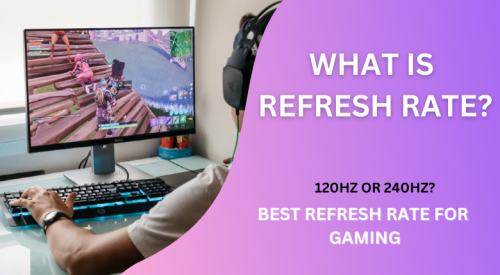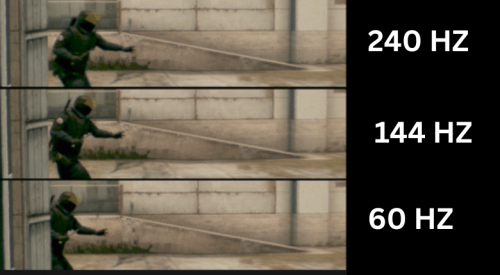What is Refresh Rate in Gaming Monitors, Laptops, TV?A Story by Refresh Rate Test You must have heard about the Refresh Rate while you are looking to buy a gaming monitor, gaming laptop, or even TV. Every gadget with a screen comes with a refresh rate. For gaming, refresh rate plays a significant role and that is why brands show off the highest refresh rates in their gaming monitor, laptops, tv, and gaming smartphones. What is Refresh Rate? In a very simple and layman’s language, a refresh rate is the ability of a display to process a new image every second. That means the number of times a new image appears on the display in one second is called Refresh Rate. The more images per second, the smoother the video will look, and vice-versa. The refresh rate is measured in Hertz (Hz). So, if you are seeing a gaming monitor with a 240hz refresh rate, that means it can process 240 images per second. In other terms, that would be a 240FPS display. FPS means, Frames Per Second. Let’s see the refresh rate from another perspective. Have you ever played with a flipbook? The more pages will give you a smooth animation. Now consider pages as Frames and every flip in one second is the Refresh Rate of that flipbook. By default, every monitor, tv, laptop, the smartphone has a refresh rate of 60hz. It is a basic refresh rate in every non-gaming office monitor and other non-gaming displays. But it increases as you move to the premium segment of displays, especially gaming displays. Refresh Rate in Gaming Monitor, Laptops, TV Now you have an idea about the refresh rate. You also know that more Frames per second gives you better & smoother gameplay. Gaming is all about smoother animations. No one likes laggy, slow animations in gaming.To get smooth gameplay with a smooth rendering of graphics, your gaming monitor must have a higher refresh rate. Refresh Rate in Gaming Monitors There are gaming monitors with 75hz, 120hz, 144hz, 240hz, and even 360hz refresh rates but don’t get too excited here. A 240hz refresh rate gaming monitor doesn’t mean you will get 240FPS gameplay right away. There is a complex tech behind the high frame rates and rendering. You need a GPU, CPU, and RAM that is capable to render graphics at 240FPS at a certain resolution. The resolution also plays a significant role here. Full HD 1920x1080p resolution can give you 240 FPS gameplay but with that same hardware, you will not be able to get 240FPS at 4K resolution. Here is how Refresh rates affect your gameplay. Pricing also matters a lot. An affordable gaming monitor can offer you a 120hz or 144hz refresh rate but for 240hz gaming monitors, you have to move towards the premium spectrum of gaming monitors. You will also see Adaptive-Sync technology that syncs the gaming monitors and GPU. If there is miscommunication between the gaming monitor and GPU, it will give you screen tearing. To get rid of screen tearing, Nvidia came with G-Sync Technology and AMD came with FreeSync technology. A gaming monitor with G-Sync is slightly more expensive than FreeSync gaming monitors. So, if a salesman is trying to sell a gaming monitor by boasting its refresh rate, wait and think if you have GPU and other hardware to render high FPS graphics. A high refresh rate gaming monitor alone will not be enough. A powerful rig is also required combined with a high refresh rate gaming monitor. The gaming laptops these days also come with 120hz and 144hz displays which makes more sense as you already have the required GPU and CPU to render the graphics on a 144hz display. Most games like CSGO, Battlefield, COD, Overwatch, etc are capable to give you 140+FPS at Full HD resolution with at least GeForce GTX 1650Ti GPU. There are games like GTA V, Microsoft Flight Simulator, etc that need more computing power to render graphics at 140+ FPS. These games are hard to run because of high graphics and you need a better CPU, RAM, and GPU to run these games in high FPS. Most gamers also like to have big screen 17-inch laptops for gaming that can give a better gaming experience and most of the gaming laptops with 17 inch displays will offer you a 144hz refresh rate. Refresh Rate in Gaming TV The refresh rate doesn’t matter if you are a casual tv watcher and you don’t need to play games on your tv. But if you are a console gamer who is planning to get the latest PS5, Xbox Series X, or already have a PS5, the refresh rate matters a lot to you. Most of the TV comes with a 60hz refresh rate but there is some TV that now comes with a 120hz refresh rate. Because a lot of console gamers use TV as their gaming display. To get the advantage of PS5’s 120FPS gameplay at 4K resolution, you need a TV with a 120hz refresh rate. Not just that, the TV must have HDMI 2.1 port and your TV and PS5 are connected with high bandwidth HDMI cable that supports 48GBPS of bandwidth. Without HDMI 2.1 port, you will not be able to get 120FPS gameplay with PS5. A standard HDMI 2.0 port is capable to give you 120FPS gameplay at 1440p resolution but if you are seeking gameplay at 4K resolution, make sure your TV has a 120hz refresh rate and is equipped with HDMI 2.1 port. Best Refresh Rate for Gaming  If you are seeking one answer to your Refresh Rate queries, let me tell you, there is no answer to this question. No one's refresh rate is good for gaming. Everyone has their expectations, requirements, and plans. What is satisfactory for me might not be enough for an export champion. For competitive gaming, every frame matters. They do need high refresh rate gaming monitors with top-notch hardware to render those graphics-intensive games but it is not required for a beginner who is just starting to play games and not earning his/her own money. For an average gamer, 120hz and 144hz refresh rates are good enough to enjoy the games at high FPS. For rendering 120hz and 144hz refresh rates, here is what you need. For 120hz at Full HD 1920x1080p Resolution: CPU: 5th Gen Intel Core i5 or AMD Ryzen 5 8 core Processor RAM: 16GB Dual Channel DDR4 RAM GPU: GeForce GTX 1650Ti (Basic GPU). You can go for a better GPU as well Display: Full HD 1920�-1080, 120hz refresh rate, DisplayPort, HDMI 2.0 connectivity Storage: SSD This configuration is good enough to give you 120FPS gaming at Full HD resolution. For 240hz at Full HD Resolution: CPU: 11th Gen Intel Core i7 or AMD Ryzen 7 processor RAM: 16GB Dual Channel DDR4 RAM GPU: GeForce RTX Series Display: 1920x1080p Resolution, 240hz refresh rate, DisplayPort 1.4, HDMI 2.0 ports For 120Hz at 4K Resolution: CPU: Intel Core i9 or AMD Ryzen 9 processor RAM: 32GB Dual Channel DDR4 RAM GPU: GeForce RTX 2080Ti Display: 3840x2160p Resolution, 120hz refresh rate, DisplayPort 1.4, HDMI 2.1 ports, and 48GBPS HDMI 2.1 cable If you are building a gaming PC from scratch, you better research before going for the false expectations of high FPS gaming based on the monitor’s refresh rate. For the best portable gaming, you can also consider large screen tablets in the premium segment like iPad Pro, Samsung Galaxy Tab S8 Ultra, etc. Conclusion So that is all about Refresh rates and how it affects your gameplay. Refresh Rate plays a crucial role when it comes to gaming. The more the refresh rate, the better would be the gameplay but you do need to take care of other hardware. A gaming laptop is something that comes as a complete bundle but if you are building a gaming PC, make sure it meets the basic requirements to run a high refresh rate. On the other hand, a refresh rate on tv doesn’t require much research. If you are planning to connect gaming consoles like Xbox Series X or PS5, make sure you are using the high bandwidth HDMI cable and the TV must have HDMI 2.1 port with a 120hz refresh rate. That is pretty much about the refresh rate in gaming and how it can affect your gameplay. You also got an idea about the best refresh for gaming and refresh rate for a gaming monitor. Let’s discuss more in the comments below. © 2023 Refresh Rate TestAuthor's Note
|
Stats
162 Views
Added on January 17, 2023 Last Updated on March 10, 2023 |

 Flag Writing
Flag Writing